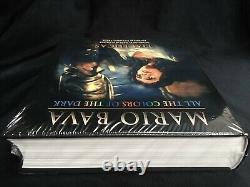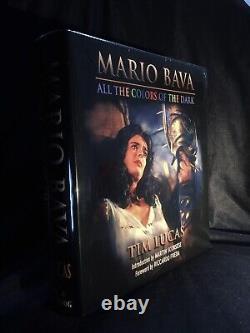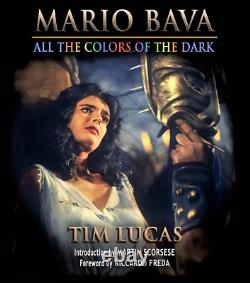
- Home
- Format
- Illustrator
- Isbn
- 0615739679 (2)
- Doesnotapply (15)
- 9780228018902 (2)
- 9780500017241 (3)
- 9780692592410 (2)
- 9780760765340 (2)
- 9780847831500 (2)
- 9780900390548 (2)
- 9780915684137 (2)
- 9780942949407 (2)
- 9780972592017 (2)
- 9781477805985 (2)
- 9781564161789 (7)
- 9781569711651 (3)
- 9781614287490 (2)
- 9781631493003 (2)
- 9781851498680 (2)
- 9781892622099 (2)
- 9781944929220 (3)
- 9788175053922 (3)
- ... (3370)
- Item Height
- Item Length
- Language
MARIO BAVA All The Colors Of The Dark HARDCOVER Tim Lucas BRAND NEW SEALED


















M A R I O B A V A. ALL THE COLORS OF THE DARK. FACTORY SEALED BY THE PUBLISHER. Mario Bava: All the Colors of the Dark.
Dimensions in inches: 10.85w x 11.87h x 2.63d. Dimensions in centimeters: 27.6w x 30.1h x 6.7d. Full-Color French-Fold LAMINATED dust jacket. 12 lbs (5.45 kgs). Few books have been as much of a labor of love.
As Tim Lucas' Mario Bava: All the Colors of the Dark. This highly sought after hardback is meticulously researched, profusely illustrated, spanning 1128 pages, and weighing a hefty 13 pounds, the tome is the definitive work on the artist as a director, cinematographer, special effects artist, and uncredited collaborator. Based on the subject matter of many of Bava's best films, it is also appropriate that the hefty volume could potentially be used as a murder weapon. 5.0 out of 5 stars.Not just a mere Book.. Tim Lucas' MARIO BAVA: ALL THE COLORS OF THE DARK, is a masterpiece. It took me years to finally make it happen, and when I secured my copy I carefully held it aloft as if it were some kind of trophy. Its remarkably researched and beautifully made.
I can't recommend this book enough. This is a work of art... The price is forever going up on this.
Glorious material portrait of Bava. That will never be reproduced in print.
SEALED IN SHRINK WRAP by the publisher. Career of influential cult director Mario Bava becomes.The work of a lifetime by noted genre expert Tim Lucas. "Tim Lucas has devoted himself to getting the word out about Bava's greatness, " writes film director Martin Scorsese (Goodfellas, The Departed) in his Introduction to Mario Bava All the Colors of the Dark (Video Watchdog), [and] this book is the pinnacle of his efforts.
Indeed, in this massive critical biography -- the product of interviews with more than 100 colleagues, friends and family members, and 32 years in the making -- Lucas explores in unprecedented detail the life and legacy of one of the most original, influential, and secretive filmmakers of the 20th century. Best known as the maestro of many aggressively cinematic, candy-colored Italian horror and fantasy films (Black Sunday, Black Sabbath, Danger: Diabolik), Mario Bava spent the first twenty years of his career as one of Italy's leading cinematographers, during which time he was helped to cultivate the screen personas of such actors as Aldo Fabrizi, Gina Lollobrigida, and Steve Reeves. He was literally present at the beginning of each new form of cinema native to his country, from operettas to neorealism to sword and sandal movies to Spaghetti Westerns.
Most importantly, he was the principal visionary behind the Golden Age of Italian fantasy, which lasted from 1957 until his death in 1980. Ow, for the first time in any language, Lucas explores Bava's first two decades of cinematographic achievement, as well as his next two decades as a director whose work has been acknowledged as a major influence by such filmmakers as Scorsese, Tim Burton, Quentin Tarantino, Joe Dante, and Guillermo del Toro. In the course of his research, Lucas discovered that Bava often contributed uncredited direction, photography or special effects to the films of friends in need, and provides entire chapters of documentation elucidating this Secret Filmography. Also included is the story of Mario's father and mentor Eugenio Bava, a silent film cameraman and the father of Italian special effects, who rose from contributing set decoration to Pathe Freres shorts to photographing Quo Vadis? From creating special effects for Cabiria to an executive wartime position in Mussolini's film factory, the Istituto LUCE.
The cumulative result is not just the story of "the supreme visual poet of the Italian gothic cinema" (The Penguin Encyclopedia of Horror), but a century-long family saga that occupies the first hundred years of Italian popular cinema -- a history not previously explored in English in such detail. A staggering, 12-pound labor of love, interweaving biography, history and criticism, Mario Bava All the Colors of the Dark consists of 1128 pages of four-columned type nearly 800,000 words! , fully illustrated with well over 1000 stills and annotated poster art from all over the world, most in full color and all subjected to a three-year process of meticulous digital restoration. Included are never-before-published family photos, documents, and drawings by Bava himself, and an eye-popping array of images that Bava fans never expected to see: a wealth of color shots taken on the set of the B&W classic Black Sunday, the only photos taken of Catherine Deneuve while briefly cast as the female lead in Danger: Diabolik, and dozens of pictures of the notoriously camera-shy director himself.
The extensive appendices include filmographies for Mario and Eugenio Bava, international discography and videography, name and film title indexes, and a generous gallery of storyboard art by Bava, including his complete art for an unproduced 1970s project, Baby Kong. With an Introduction by Martin Scorsese and a Foreword by the late Italian director Riccardo Freda, Mario Bava All the Colors of the Dark marks an exciting new development in the fields of film-related biography and book-making.
Simply to page through this remarkable tome, as overpoweringly visual as any of Bava's own films, is to feel like you're watching an epic film. Hardcover, clothbound, gold stamping on front and spine. Full-color French-fold laminated dust jacket. This book deserves a place on the bookshelves of all serious film lovers. I don't know what Mario Bava would have made of all this, but wherever he is, he must be blushing Technicolor crimson... Joe Dante, director of Gremlins and The Howling. No one knew the circles of Hell like Bava. And in Tim Lucas we have found our perfect Virgil. This is a beautiful, beautiful book. Perhaps the ultimate movie book, certainly the ultimate Bava book. Clearly a labor of love, 30 years in the making, All The Colors Of The Dark is an astounding achievement and an example of book that could never deliver its experience digitally. You have to read the real thing, feel its heavy weight in your hands, and marvel at the gorgeous layout. Nothing but love went into this book, and Mario Bava could not have a more worthy tribute. Saturn Award for Special Achievement.Rondo Hatton Classic Horror Award. Foreword by Italian Horror Pioneer.
The Complete Story of Mario Bava's life and careers as director, cameraman and special effects artist. Interviews with more than 100 actors, co-workers, friends and family members. The Definitive Study of each of his films: production histories, cast biographies, critical analysis, and video information. Never-before Published Photos including the only color shots taken on the set of BLACK SUNDAY.
Original Mario Bava Storyboards - including the boards for the unfilmed project BABY KONG. Original Mario Bava Artwork - Some in Full Color! Bava's Secret Filmography: His uncredited works as director, cameraman and special effects artist. Eugenio Bava (Mario's father) Filmography. Tim Lucas is the editor and co-publisher of the award-winning monthly Video Watchdog, The Perfectionist's Guide to Fantastic Video.
His articles, essays, and criticism have appeared in dozens of magazines in America and abroad, including Film Comment, Cahiers du Cinema, American Cinematographer, Fangoria and Cinefex. He is also a published novelist (Throat Sprockets, The Book of Renfield) and comics writer (Taboo), a DVD audio commentator, an award-winning blogger (Video WatchBlog), and a monthly columnist for the British magazine Sight and Sound. Mario Bava directed (or co-directed) twenty-four features during an eighteen year period, 1960 to 1978. His oeuvre consists entirely of the formula films (filone) which made Italy the most successful production center in Western Europe in the'60s.Bava is best known for his horror films and giallo thrillers (to which I will turn shortly), but he worked in all of the popular genres of his day: spaghetti westerns, peplum/sword-and-sandal epics, Bond-style spy thrillers, even soft-porn Mondo Cane/World by Night romps. If Bava manages, more often than not, to transcend the limitations of his material it is because of the strength of his imagery, as well as the evident pleasure he derives from exploring the expressive potential of the medium itself: the ability of film to generate a variety of emotions - most of all, wonder and fear. "Movies, " Bava once explained, are a magician's forge, they allow you to build a story with your hands. At least, that's what it means to me. What attracts me in movies is to be presented with a problem and be able to solve it.
Nothing else; just to create an illusion, and effect, with almost nothing. His apprenticeship in cinematic magic began quite early. His father, Eugenio Bava, was also - as Tim Lucas puts it - the father of special effects photography in Italy. Eugenio Bava began working at the Italian branch of Pathé Frères in 1906. (In the years leading up to the Great War, Pathé Frères was the most successful film company in the world).His credits include cameraman for Quo Vadis (Enrico Guazzoni, 1913) and Cenere (1916) with Eleanora Duse. He also worked with Segundo de Chomon on the special effects for Pastrone's Cabiria (1914) and later became the head of the optical effects department at the government-sponsored i. Mario Bava, after serving as an assistant to his father, became a camera operator and cinematographer.
Among his earliest works as Director of Photography (DP) were two shorts by Roberto Rossellini: Il tacchino prepotente and La vispa Teresa (both 1940). Bava spent the next twenty years refining his craft, serving as a cinematographer on nearly thirty features before directing his first film Black Sunday (La Maschera del demonio, 1960), at the age of forty-six. His subsequent career could be understood as a continuation by other means of his work as cinematographer, for it is clear that Bava's approach to filmmaking is primarily cinematographic. Henri Alekan, the great French DP, once said that the cinematographer's task was "to obtain psychological reactions out of mere technical means" and this is a good, basic description of Bava's style. When Andrew Mangravite says that Blood and Black Lace (Sei donne per l'assassino, 1964), one of Bava's best films, is "a thriller'about' shadowy rooms, and the terrors of nightfall" he does not exaggerate.
Bava's films are primarily about the effective qualities of light and shade, of color and movement. He is credited as his own cinematographer on eight of his twenty-five features, but even when he did not officially shoot his films Bava took an active role in the design of each image: setting up the lights, taking charge of the little red wagon which served as his makeshift dolly, creating optical effects with glass mattes, etc. The artisanal nature of Bava's filmmaking extends to story construction as well, for the haphazard nature of film production in Italy gave Bava substantial freedom to rework scripts as he saw fit. He was known to change as much as sixty percent of the material while in production and even postproduction. This was not a problem, dialogue-wise, since Italian films were typically postsynchronised.
The writing credit given to film editor Mario Serandrei on Black Sunday, as Lucas suggests, is more than likely an acknowledgement of the contribution that Serandrei made to the story after it was shot. If you ever complained, while watching an Italian genre film, that the plot "seems to have been made up on the spot, " this, in fact, is not far from the truth. There is a playful allusion to this in Lisa and the Devil (Lisa e il diavolo, 1972) when Sophia, one of the characters stranded in an old family mansion, observes, The entire setting is so right for a tall tale of gloom and perdition.
Why, we can make one up as we go along. Bava remains best known for his first film, Black Sunday.The prologue, in particular, seems engraved in the minds of those who have seen it. We are in seventeenth century Moldavia. A woman has been sentenced to death.
A poker with the letter's' is held over an open flame. When it is red-hot it is used to sear the prisoner's flesh - to mark her with the brand of Satan. This is just the beginning. The Grand Inquisitor orders that his assistants cover her face with the mask of Satan. We realize, with mounting horror, that a spike-lined bronze mask is to be secured to her face with the hammer blow of a hooded executioner. As the executioner advances, mask in hand, we are placed in the position of both victimizer and victim: first, we see the woman from the point-of-view of the mask, then a shot from her perspective of the spikes advancing toward their prey. There are several reasons why this scene is so memorable.It is also perversely erotic. The sexual nature of the events we are witnessing is alluded to in both speech (we are told that Princess Asa is being punished for her "monstrous love" for Prince Javutich) and in the visuals: the close-up of Asa's seared flesh (the indentation caused by the red-hot poker); the spiked-lined mask with its promise of a defilement-without-end. This confluence of brutality and eroticism does not contradict the initial impression of childhood recollection, but enhances it - for was not the whole world once charged for us with such obscure sources of pleasure and terror? In psychoanalysis, Freud will discuss this confluence by way of the primal scene.
This sequence could serve as the prologue to just about every film Bava has ever made. Each of his works seems somehow a consequence of this originary trauma, this initial (initiatory) act of violation.
As though each subsequent work were an attempt to understand, to unfold, the repercussions of this originary event. Nowhere are the repercussions more deeply felt than in the trio of works which Bava made in quick succession between 1963 and 1964: Black Sabbath (I tre volti della paura, 1963), Whip and the Body (La frusta e il corpo, 1963), Blood and Black Lace. Whip and the Body is virtually a color remake of Black Sunday. It shares the earlier film's general climate of stagnation; each work centered on a family haunted by a past, a past which exhausts the present with each waking hour.
Certain shots "echo" ones from the earlier film: the camera gliding across the room as a woman sits and plays the piano; a family hearth opening to reveal a secret passageway; an old man terrorized in his bed late at night. Compare, as well, the denouement of both films. Black Sunday ends with Princess Asa finally consigned to the flames promised two hundred years before, but rather than produce a sense of closure Bava's emphasis on the joyful sounds of the villagers gives us pause: there is a little too much pleasure in this act of destruction and death. Isn't this simply Asa's "beautiful life of evil and hate" in another guise? In Whip and the Body, Bava "answers" the words of Christian, his hope that Nevenka has found peace in death, with a shot of a piece of rope coiling, writhing in flames (the coil of rope a motif associated with Nevenka and her "desire" for her deceased lover Kurt). The flames grow progressively larger until they finally consume the screen.As Lucas notes, the final image allows us to imagine [Nevenka's] reunion with Kurt on a more elemental level. The most notable difference between the two films - and it is what makes Whip and the Body even more remarkable than the previous work - is that instead of focusing on the banal "good" couple (Katya and Adrej in Black Sunday, Tanya and Christian in Whip and the Body) it concentrates on the "evil" one: the monstrous (possibly, incestuous) love of Asa and Javutich in Black Sunday becomes Whip and the Body's Sadean romance between Nevenka and Kurt Menliff.
As Nevenka, Daliah Lavi (best known for her role in Vincente Minnelli's Two Weeks in Another Town, 1962) is absolutely stunning. We are made to feel the severity of her fear and longing, especially as she is ferociously whipped, barely able to contain herself.Nevenka lives in a state of perpetual anxiety. She's not sure what idea is more frightening to her: that Kurt has come back from the dead to haunt her; that he has not.
His most beautifully sombre work, Whip and the Body turned out to be Bava's most controversial. The producer was put on trial for charges of obscenity, and it was later distributed abroad in heavy edited versions in the US, it was released with the unforgivable title What! Whip and the Body transforms a tale of ghosts and sadomasochistic violence into a classic work of l'amour fou, alongside Buñuel's L'Age d'or (1930) and Wuthering Heights (1953), Joseph H.Lewis' Gun Crazy (1949) and Hitchcock's Vertigo (1958). Although Black Sabbath consists of three separate stories, set in different historical periods, they can also be read as variations on a theme. This is clearest in the repetition of details between the first story ("The Telephone") and the third ("A Drop of Water"), both of which chart the emotional collapse of a. Single character, a woman alone in her apartment.
The breakdown, in both cases, is precipitated by a telephone call. Between the first and last story, the material is repeated and transformed. Whereas "The Telephone" takes place in the present, "A Drop of Water" takes place in an indeterminate past. If the threat in "The Telephone" turns out to be all-too-human (a disgruntled ex-lover - two, in fact - driven to commit acts of cruelty), the threat in "A Drop of Water" is purer, more primordial. Here, the revenge is carried out by the dead.
This revenge of the dead on the living, of death on life, gains additional power because of its placement after the second narrative, "I Wurdulak". In this variation on the vampire myth, the wurdulak is driven not so much by a need for blood but by a need to reunite with their loved ones in (or through) death. When, at the end, the (living) protagonist says to his beloved, "You know I'd rather die than lose you", he gives her the confirmation of his love which she needs to reunite for all eternity. The trio of stories thus function dialectically to produce one final face of fear: at the end of "A Drop of Water", the camera slowly zooms in on the dead heroine's wild-staring eyes.The coda - added by request of the distributors - somewhat dilutes the power of the last shot, but it has a charm all its own: Boris Karloff, star of "I Wurdulak", on set with technical crew, riding a mechanical horse. This self-reflexive gesture allows us to understand both the magical properties of cinema and the emotion we invest in it.
A near abstraction on colour and movement, Blood and Black Lace is Bava's cinema distilled to its cruel essence. This film develops with complete abandon what Bava more tentatively explored in The Girl Who Knew Too Much (La ragazza che sapeva troppo, 1962) and "The Telephone" episode of Black Sabbath.
From the opening image (an unhinged sign for Christiana's Haute Couture banging in the wind) to the last (a telephone receiver off the hook swinging like a pendulum, back and forth) we have a remorseless, inexorable movement, a dissipative force, that levels everything in its path. This movement becomes, in the case of Nicole's murder in the antique shop, a pulsation of light, by which one means not only the neon sign which flickers off-on, off-on as the woman meets her demise with a medieval iron hook (a variation on the death mask of Black Sunday; later, Mary's demise by way of a red-hot furnace will duplicate the searing of Asa's flesh), but Bava's use of primary colours which throb with an intensity all their own. That Bava's source of inspiration was a lurid type of pulp magazine itself identified by a specific colour, giallo (yellow, the colour of terror, of fearfulness), couldn't be more appropriate. In his taxonomy of cinematic signs, Gilles Deleuze suggests that Bava's work be understood in relation to what he calls "the impulse-image" (l'image pulsion). In the cinema of impulse-images, the viewer perceives a primordial world of drives and forces immanent within and inseparable from the real world of concrete particularities.
There is the co-existence of two worlds, each implicated in the other: an originary world of atavistic impulses and a material world of concrete particulars. Exists and operates in the depths of a real milieu, and is only valid through its immanence in this milieu, whose violence and cruelty it reveals. Did you really expect us to be any different? ; in Lisa and the Devil, the heroine, a German tourist in Toledo, Spain, momentarily strays from her tour group and - with the simple act of turning a street corner - discovers another world, a parallel world, in which she also seems to belong, to have always already belonged.
My favourite example is found in Five Dolls for an August Moon (Cinque bambole per la luna d'Agosto, 1970). The island retreat where the rich industrialist and his friends gather - only to be slaughtered, one by one - is both concrete and primordial. One contact point between worlds is the walk-in freezer where all the corpses are covered in plastic and hung on hooks like slabs of beef.
The weak narrative explanation for this event later in the film hardly matters since there is a logic to this momentary disappearance which defies all rationale explanation. In the cinema of impulse-images, the emphasis is placed on drives rather than desires. The drive precedes individuation, whereas desire can be understood as the individuated expression of elementary drives.
The intensity of emotion (fear, hatred, love) is never simply the personal attribute of a specific character. Impulses, primordial drives, pass from the milieu to the characters and back again. In Bava's early films, the force of the impulse is conveyed by camera movements, by lighting, and by color. It is through such techniques that Bava communicates the violence of the impulse. Technicolor, for example, allows Bava to foreground color as a form of expression in its own right. In such works as Whip and the Body and Blood and Black Lace, color is experienced by the viewer as color, the transmission of a specific quality or vibration, before (or beyond) its actualization in characters and narrative events. Primary colors become manifestations of elemental forces, brute instincts. This is one reason why the flimsiness of the plot and the characters is easily overlooked in his best films: the plot and characters are insubstantial in contrast to the impulse itself. The reader might ask here whether the appearance of impulse-images in Bava is simply a consequence of the genres in which he primarily worked (gothic horror, giallo thrillers). Yet, we should not overlook that it was Bava himself who chose to transform a story by Gogol into Black Sunday or that it was Bava who initiates the giallo thriller. So, rather than say that the impulse-image is a consequence of the genre and not the auteur, I would argue the reverse: Bava's inclination for impulse-images is what leads him to such genres (in fact, leads him - in the case of the giallo - to create a new one). It is the genre trappings which give Bava free rein to explore the various facets of the impulse-image. By the time we get to his late masterwork Rabid Dogs (Cani arrabbiati, 1974), Bava no longer even needs the generic trappings.Rabid Dogs is neither horror nor giallo, yet it is pure impulse-image. Bava presents for the viewer a vision of the'real world' more horrific and brutal than any of his stylized giallo films. The hijacked vehicle, travelling down a highway on the outskirts of Rome with three criminals and three hostages, becomes the ultimate manifestation of the originary world and elementary impulses. The trailer for the film neatly summarizes this as well, informing us that the film is about "Hunting.
Killing", before announcing, The destination is death. Bava's directorial career can be roughly divided into two periods. During his first six years as a filmmaker, Bava directed over a dozen films and it is during this initial burst of activity that he made many of his best films. 1966 was a year marked by personal and professional misfortune: the death of his beloved father; the death of Mario Serendrei, his film editor (who also worked with Luchino Visconti); the end of Bava's collaboration with cameraman Ubaldo Terzano, who began working as Bava's camera operator in the early 1950s and became his director of photography with Black Sabbath. Although his title was believed to be purely nominal (since Bava took on most of the responsibilities associated with a DP), there is a striking difference between the works Bava made with Terzano and the ones he made, beginning in 1965, with Antonio Rinaldi and others.The Bava-Terzano films are distinguished by the remarkable motility of the camera, even more remarkable when you consider that, with the exception of Black Sunday, they never had the budget to rent professional cranes and dollies. Look, for example, at the intricate use of camera movement during the opening minutes of "The Telephone". There are multiple long takes here in which the camera executes five or six movements within a single shot. What Bava and Terzano convey so vividly with these movements - as well as the use of several startling 180º reverse cuts - is the terror of being "exposed" in one's own home. The continuous variation of angles and points-of-view remind us that, even within the interior of one's abode, there is always some other corner to explore, some other perspective yet unknown.
In Blood and Black Lace, the camera laterally tracks back and forth across the dressing rooms of Christiana Haute Couture allowing us to view, in a continuous take, a series of models (and future victims) in various states of dress and emotional distress. These movements allow us to experience firsthand the turbulence into which these characters' lives swiftly descend. After the termination of the Bava-Terzano partnership, Bava's films become increasingly more static. Considering his background as cinematographer it is not surprising that the division in Bava's oeuvre would express itself, first and foremost, in visual terms. The physical, sensual qualities of the tracking shot are replaced by the faux-movement of the zoom lens.
Of course, the zoom lens can produce its own thematic resonance and one effect which particularly appeals to Bava is the way a zoom-in flattens space, momentarily abstracting the characters from their surroundings, like cut-out figures, so that we see them both within a specific milieu as well as abstracted from it. But whereas the use of the zoom lens in a film like Hatchet for the Honeymoon (Il rosso segno della follia, 1968) has a sense of experimentation about it - Bava researching its expressive potential - the overuse of zoom shots in the works to follow signal (or seem to signal) the director's indifference to the material at hand. The more static nature of Bava's later works, I might add, is not as evident in the first Bava-Rinaldi collaborations, such as the wonderful sci-fi horror film Planet of the Vampires or Kill, Baby, Kill! [Operazione paura, 1966], whose most dazzling sequence involves a young girl drawn to a metal protuberance like a moth to the flame, her "attraction" communicated by the complex movements of the camera.What differentiates the two periods as well is the use of color. The early color works were shot or processed in Technicolor. The later were made using inferior color film processes. The vibrant, saturated colors which give such Bava films as Hercules in the Haunted World and Whip and the Body a hallucinatory beauty gives way in the later works to poor contrast and pallid colors, as though the world itself had become impoverished, had lost its allure - its threat.
The increased emphasis on location shooting will also restrict Bava's use of expressive lighting effects. Bava would experience the adversities of commercial filmmaking in Italy with growing intimacy. Somehow, as his body of work expanded, the scripts became increasingly more threadbare, the budgets and production circumstances more precarious. Bava and the cast of Kill, Baby, Kill! Despite this, it is a wonderful mood piece. At the premiere, it is said that Visconti gave the film a standing ovation. Bava agreed to step-in and salvage the Viking film Knives of the Avenger (I coltelli del vendicatore, 1966) by reworking the script and reshooting almost the entire film in six days.Bava began shooting Five Dolls for an August Moon forty-eight hours after signing a contract to make the film. These mishaps would continue to the end. Unable to secure a distributor, the producer Alfred Leone (under the pseudonym Mickey Lion) shot new footage and transformed Lisa and the Devil into an Exorcist knock-off entitled House of Exorcism (La casa dell'esorcismo, 1975) (14). To add insult to injury, Bava's last theatrical release Shock (All 33 di Via Orologio fa sempre freddo, 1977) was marketed in the US as a sequel to another Exorcist retread, Ovidio G. Assonitis's Beyond the Door (1975).
Worse, though, was the fate of Rabid Dogs. The producer declared bankruptcy while the film was in the final stages of production and his property (including the workprint of Rabid Dogs) was seized and impounded. It would not see the light of day for twenty-three years (seventeen years too late for Bava, who died in 1980). Yet, despite these professional difficulties, Bava's final trio of films can now be seen for what they are: a marvelous return to form.Lisa and the Devil was Bava's reward, by producer Leone, for the commercial success of Baron Blood (Gli orrori del castello di Norimberga, 1972) and it is his most daring film, an oneiric narrative with tender volleys of absurdist humor. As Lucas writes, it is an extraordinary combination of horror film, art film and personal testament. Based on Bava's memories of growing up among his father's sculptures, dialogue borrowed from Dostoevski's I Diavoli, and an unrealized project about real-life necrophile Viktor Ardisson, Lise e il diavolo unfolds like a waking dream. Although it doesn't quite sustain the invention and charm of the opening hour, Lisa and the Devil is clearly a labor of love, a beautifully crafted puzzle box replete with secret compartments. Shot on location with little or no artificial lighting and set for almost its entirety in a moving car there is nothing dream-like about Rabid Dogs.
Three robbers on the run from the police with three hostages: a man, a woman and a child. It is as brutally precise as any film Bava has ever made. The film starts at a fevered pitch (a robbery gone awry) and never lets up.Rabid Dogs consists primarily of a series of remarkable close-ups of the human face in crisis. No matter what emotion is expressed - joy or terror - the one quality which unites all these human countenances is their nakedness.
Bava's study of the human face is a perverse variation on the "symphony of faces" found in Carl Dreyer's Passion of Joan of Arc (1928). Whereas the face in Dreyer is both flesh and spirit (made of flesh, but turned toward the spiritual), the face in Bava is nothing but flesh, pure and simple. Working with a script written by his son Lamberto Bava, in collaboration with Francesco Barbieri, Paola Briganti and Dardano Sacchetti, Shock has a gravitas missing from Bava's middle-period films. The flippant tone of such works as Bay of Blood (Ecologia del delitto or Reazione a catena, 1971) is replaced here by a real sense of pain and anguish.The denouement is a worthy finale to Bava's film career: a mother, pushed to the brink of madness and despair, slits her throat in the basement of her house while, outside, her little son "plays" with the ghost of his father (he serves imaginary tea to a man who isn't there). Earlier in the film the mother explained to her son that "Death is a part of life, and we must learn from it", but even she could not have realised what these words would come to mean - for her son or for the viewer. In his final series of works, Bava manages to reaffirm his belief in the alchemic properties of film, its ability to convert "almost nothing" into images of terror and beauty.
The cinema is a magician's forge and Mario Bava is one of its master sorcerers.
